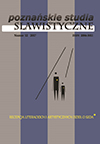Kunst im Holocaust: Zu Josef Bors Novelle Terezínské rekviem und ihrer Rezeption
Art in the Holocaust: On Josef Bor’s Novella Terezínské rekviem and its Reception
Author(s): Reinhard IblerSubject(s): Theatre, Dance, Performing Arts, Jewish studies, Music, Czech Literature, History of the Holocaust
Published by: Uniwersytet Adama Mickiewicza
Keywords: Josef Bor; Holocaust; novella; reception; Terezín; Rafael Schächter; requiem; Giuseppe Verdi;
Summary/Abstract: Ibler Reinhard, Kunst im Holocaust: Zu Josef Bors Novelle Terezínské rekviem und ihrer Rezeption (Art in the Holocaust: On Josef Bor’s Novella Terezínské rekviem and its Reception). “Poznańskie Studia Slawistyczne” 12. Poznań 2017. Publishing House of the Poznań Society for the Advancement of the Arts and Sciences, pp. 167–179. ISSN 2084-3011. The name of the Czech writer Josef Bor (1906–1979) is nearly forgotten today, although he was very successful with two works in the sixties. Both works deal with the Holocaust. The novel Opuštěná panenka (1961) is inspired by the author’s own horrible experiences at Terezín, Auschwitz and other places of the Holocaust. In 1963, the novella Terezínské rekviem followed which is subject of this paper. Bor’s novella is about the Jewish musician Rafael Schächter and his staging of Verdi’s Requiem at Terezín. From the viewpoint of reception, this work is interesting on two counts: on the one hand, in the story the reception and interpretation of art play a crucial role, on the other hand, there are some special features in the reception of the novella itself, as the work has mostly been read in the light of the real events the story is referring to, whereas the text’s literary character has often been neglected.
Journal: Poznańskie Studia Slawistyczne
- Issue Year: 2017
- Issue No: 12
- Page Range: 167-179
- Page Count: 13
- Language: German

